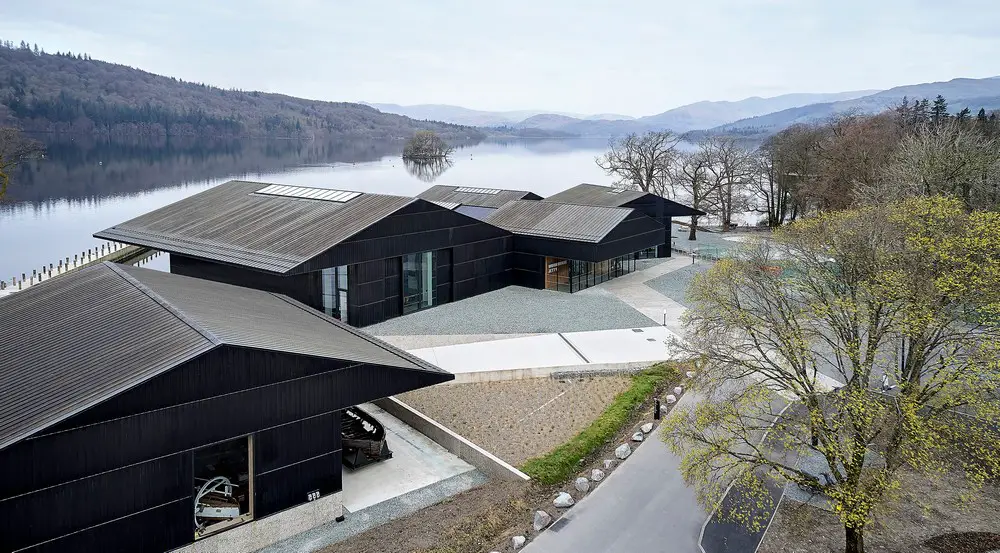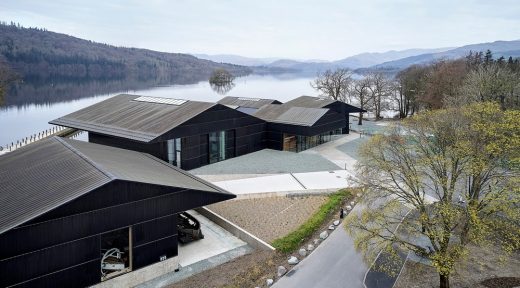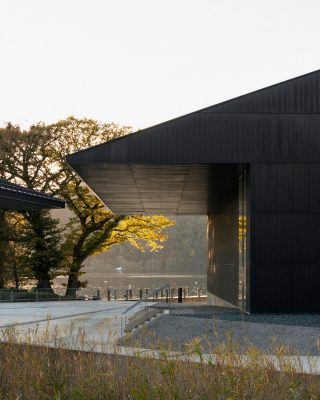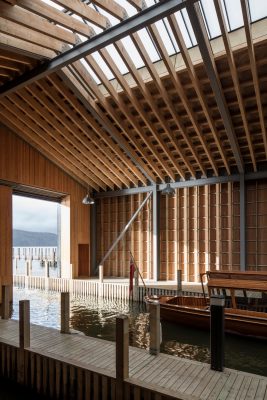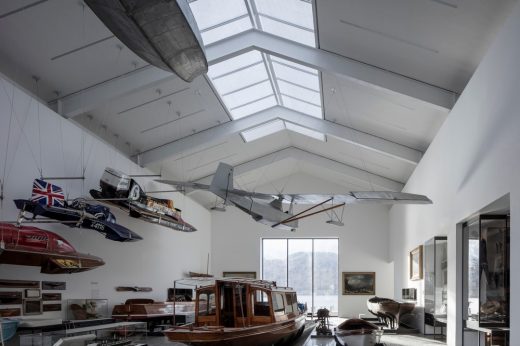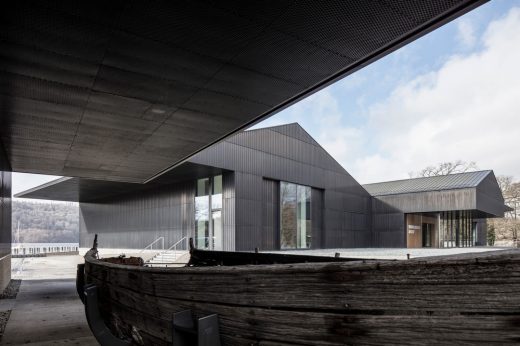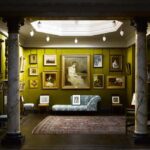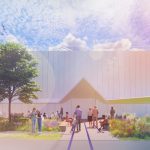Windermere Steamboat Museum Cumbria, Lake District Architecture Competition, Cafe, Architects
Windermere Steamboat Museum Building
Lake District Building Development, Cumbria, Northwest England design by Carmody Groarke, UK
post updated 17 & 16 September 2021
Windermere Steamboat Museum shortlisted for RIBA Stirling Prize 2021
Jury Report
Nestling into the eastern shore of Lake Windermere, the Jetty Museum creates a compelling composition of vernacular forms which achieves an unusual reconciliation of the reassuringly familiar with the strikingly contemporary. When seen from the lake its dark shed-like buildings are embedded in the wooded hillside behind, but on arrival the Museum exudes the confident identity of a major cultural institution.
The cluster of pitched-roof forms successfully breaks down the large scale of the museum, integrating it into its landscape setting. This seemingly picturesque arrangement derives its layout from functional requirements whilst carefully framing views of the lake. It is these views, and the experience of the water, which become the main protagonist in the considered and choreographed sequence of the visitors’ route, with the building successfully blurring boundaries between climate-controlled galleries, workshops, the wet dock and the lake itself. Learning from older Lakeland buildings, the provision of deeply overhanging eaves creates external rooms, sheltering visitors from the elements.
Everything here has been carefully considered as part of the design in terms of visual impact, functional performance and response to the context and environment. Considerable thought has been put into the selection of materials, in particular the use of oxidised copper, the primary material of the exteriors, which is already weathering to a variety of subtle natural hues.
From a sustainability perspective the Museum is highly convincing. The sustainability strategy is intelligent and comprehensive and this is clearly evident in the completed building. From the reuse of the existing wet dock, to the consideration of embodied carbon and longevity in the materials selection; from biodiversity to health and wellbeing; and from sustainable water cycle to careful selection of appropriate building services systems for each different area, sustainable thinking was embedded in the design process holistically and passionately from an early stage and carried through to completion.
The building’s important relationship to the lake, and its setting in the National Park, is reflected in exemplary strategies for water, land use and ecology. The building touches the earth lightly and sits comfortably in its setting. New landscaping complements the existing and is designed to enhance biodiversity; water use has been minimised and sustainable drainage strategies implemented.
The client, Lakeland Arts, is to be applauded for having the confidence and ambition to commission this significant piece of architecture and major building in a sensitive location at the heart of the Lake District National Park. The project has been seen through with rigour and integrity from the architectural competition in 2011 to its successful opening to the public. It has enabled Lakeland Arts to further develop their longstanding commitment to artistic and cultural engagement with visitors and the local community.
The unique setting demanded a scheme with a clear vision and of the highest quality. The resulting building has been handled with sensitivity and deftness. It has a restrained and simple beauty that is boldly confident in its design and delivery.
Windermere Steamboat Museum – Building Information
RIBA region: Northwest
Architect practice: Carmody Groarke
Date of completion: March 2019
Client company name: Lakeland Arts
Project city/town: Windermere
Internal area: 2,560.00 sqm
Contractor company name: Thomas Armstrong Construction
Consultants
Landscape Architects: Jonathan Cook Landscape Architecture
Structural Engineers: Arup
Project Management: Turner & Townsend
Quantity Surveyor / Cost Consultant: Turner & Townsend
Environmental / M&E Engineers: Arup
Access Consultant: Jane Toplis Associates
Acoustic Engineers: Arup
Fire Engineer: Lawrence Webster Forrest
Graphics: A practice for everyday life
Health and Safety Consultants: Lucion Services
Ecologist: Middlemarch Environmental
Exhibition Design: Real Studios
Approved Building Inspector: Butler & Young
Awards
• RIBA National Award
• RIBA Northwest Award
• RIBA Northwest Client of the Year
• RIBA Northwest Building of the Year
Photography: Christian Richters, Hufton – Crow and Johan Dehlin
20 Jan 2017
Windermere Steamboat Museum News
Windermere Steamboat Museum Building Construction Update
Design: Carmody Groarke Architects
This new museum on the lake displays an internationally significant boat collection.
Full advantage has been taken of the mild winter weather building up the walls of the café, learning space and reception.
The copper roof has been completed to the learning centre building and the cladding specialists have moved on to covering the reception roof.
The structural wall system has also started on the main exhibition building, the largest of the buildings, beginning to enclose the space and frame more of the views out to the lake.
A number of the roofs are nearing completion with the installation of rooflights to the boathouse and café.
Pipes and wires are also beginning to appear as the first fix for services begins around the museum buildings.
Website: Windermere Steamboat Museum Construction
1 Aug 2013
Windermere Steamboat Museum Building News
Windermere Steamboat Museum secures Heritage Lottery Fund investment
The Lakeland Arts Trust is delighted to announce that the Windermere Steamboat Museum Project has been awarded a confirmed grant of £9.4 million from the Heritage Lottery Fund (HLF).
Windermere Steamboat Museum building design by Carmody Groarke:
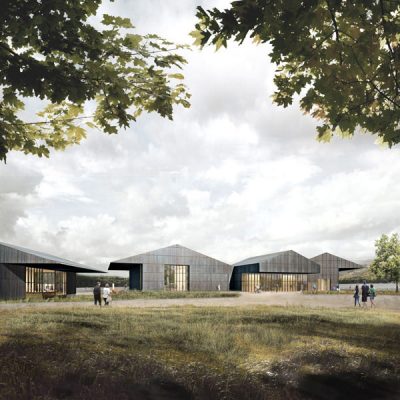
image © Carmody Groarke, from Lakeland Arts Trust
The Project will create a new museum on the lake to display the internationally significant collection, connecting boats, people and stories. The high-quality museum facilities will include a wet dock where visitors will see boats displayed on the water, collection displays where visitors can discover about the people who built the boats, who used them and how they were used, an active conservation workshop and a dedicated learning space.
New jetties will also connect people to the lake enabling visitors to arrive by boat or take a trip on a historic launch whilst the lake side café will provide exceptional views across Windermere.
Martin Ainscough, Chairman of the Lakeland Arts Trust, said: ‘This decision secures a total of £13.4 million investment into Cumbria creating employment and new opportunities for local people. I would like to thank all the project team members who put an enormous amount of work in to developing the plans for the Museum and securing this fantastic grant for the region’.
Gordon Watson, Chief Executive of the Lakeland Arts Trust, said: ‘We are delighted that the Heritage Lottery Fund has confirmed the grant to the Museum and thank them for their tremendous support. Immediate steps are to complete design development so that construction can start next year. We are looking forward to re-opening the Museum and welcoming visitors to enjoy the wonderful collection of Windermere boats and take part in exciting new activities and events inspired by the collections and beautiful site’.
Tiffany Hunt, Chair of HLF Northwest Committee, said: ‘This wonderful collection of historic boats is now set to be housed in a new and sustainable museum, spectacularly located on Lake Windermere. We felt strongly that this was a great opportunity to invest a significant amount of money in an area that relies heavily on tourism as well as reveal the social histories behind the local boatbuilding industry.
Equally important will be opportunities for people to acquire traditional skills and get involved with caring for these steamboats which are such a culturally distinctive part of Cumbria’s landscape.’ The Lakeland Arts Trust has raised over £3 million match funding for the project and needs to raise a further £300,000 to meet the total project costs of £13.4 million. The Trust is working with an excellent design team on the project including Carmody Groarke, architects, Arup, engineers and Real Studios, exhibition designers.
25 Mar 2013
Windermere Steamboat Museum Building Planning
Windermere Steamboat Museum Planning Application Submission
The Lakeland Arts Trust has applied to the Heritage Lottery Fund for a confirmed grant, having previously secured their initial support and is delighted to announce that it is applying for planning permission to redevelop the Windermere Steamboat Museum as a world-class heritage attraction and a major part of the Windermere Waterfront Programme.
This long-awaited project will enable the Museum to re-open to the public so that local people and visitors can once again enjoy seeing the unique collection of boats. All the historic boats are associated with Windermere and together they tell the history of over 200 years of leisure, industry and trade on the lake.
Gordon Watson, Chief Executive of the Lakeland Arts Trust said ‘this is an important step forward for the project to turn the Museum into a popular tourist attraction which offers a very special and exciting experience for visitors. We want to involve local people and visitors in the Museum and to offer a wide range of activities for school children, families and older people.
The new facilities are essential to enable the Museum to re-open. The Museum will create year-round employment and the economic impact assessment shows that the Museum will enable an estimated 94 direct and indirect jobs to be created and safeguarded across a range of roles. The Museum will also offer apprenticeships and training and give volunteers opportunities to develop new skills and experience.’
Martin Ainscough, Chair of the Lakeland Arts Trust said ‘the Museum will be the most significant development on Windermere over the next few years. We are seeking to invest over £13 million in South Lakeland and planning consent is essential to secure the investment. Funding from a number of organisations, including trusts and foundations as well as individual donors and the Heritage Lottery Fund, the Rural Development Programme for England and a conditional offer from the Government’s Regional Growth Fund has enabled us to develop the detailed designs and plans for the Museum.’
The Museum has the strategic support of the key agencies in Cumbria and the Northwest including the Lake District National Park, Cumbria Tourism, Cumbria County Council, South Lakeland District Council and Cumbria Local Enterprise Partnership.
The completed museum will be self-sustaining with no core statutory funding. The Museum expects to receive 100,000 visitors per annum, with between 200 – 300 groups engaging with the schools’ programme. As part of this self-sustaining vision, the Museum will:
Support the on-going maintenance and conservation of the collection.
Provide a high quality formal and informal learning programme for children, young people and adults.
Deliver a changing programme of temporary displays and public events.
The boat collection at the Museum is of national and international significance. The UK’s National Historic Ships lists 11 boats in the collection as nationally pre-eminent and four are members of the elite National Historic Fleet. The best known part of the collection is the ten classic Windermere steam launches of the 1890s and 1900s.
Other highlights include SL Dolly (1850) the oldest mechanically powered boat in the world, SY Esperance (1869) built for steel magnate Henry Schneider and inspiration for Captain Flint’s houseboat in Arthur Ransome’s Swallows and Amazons, Canfly (1922) powered by a 1917 Rolls Royce aero engine, and, in stark contrast, Beatrix Potter’s tarn boat that she used to sketch in on Moss Eccles Tarn. The Lakeland Arts Trust selected the design team for the Museum in 2011.
The architects are Carmody Groarke and they have designed a beautiful collection of buildings located around the original wet dock. Andy Groarke, director of Carmody Groarke said: ‘This is an important opportunity to create a new museum building that is right for the beautiful lakeshore of Windermere, and which can provide a world-class visitor attraction for generations to come.’
Andrew Groarke describes the design: ‘The new museum has been arranged as a cluster of buildings within the landscape on the lakeshore. The composition of its pitched-roof forms is intended to forge a strong connection between visitors, boats and water. They are characterised by large canopies which frame views to and from the lake, but also provide all weather shelter around the perimeter of the museum.
Each individual building has been designed around a very different visitor experience related to boats: on land or on water. The museum development will include exhibition space for displaying boats, telling the stories of their construction, of their owners and their use on Windermere. A conservation workshop where visitors can watch boat builders and apprentices at work on the collection will form a key element of the visitor experience.
At the heart of the of the museum will be the wet-dock where boats will be displayed on water. In addition to the core display space, a learning centre offering an inspiring programme for visitors of all ages will be central to the development, as will a new museum cafe which will take opportunity of magnificent views to the north of Windermere.’
Windermere Steamboat Museum Competition information from RIBA Competitions
13 Dec 2011
Windermere Steamboat Museum Winner
Winner announced for Windermere Steamboat Museum Competition
Windermere Steamboat Museum – winning design by Carmody Groarke:
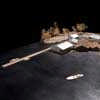
Windermere Steamboat Museum images from Lakeland Arts Trust
Windermere Steamboat Museum Competition
Carmody Groarke are announced as the winners of the competition to redevelop the Windermere Steamboat Museum in the Lake District National Park. Earlier this year, the Lakeland Arts Trust secured initial support for a £7.4m Heritage Lottery Fund (HLF) bid to take the project forward.
Windermere Steamboat Museum Design Competition information from RIBA Competitions
Location: Windermere, Cumbria, England, UK
Cumbrian Architecture
RIBA Lake District Competition
Whitehaven Harbour Design Competition : Cumbrian Architecture Contest
Cumbrian Buildings
Dove Cottage and the Museum at Wordsworth Grasmere
Exhibition, interpretation & wayfinding: Nissen Richards Studio ; Basebuild architect: Purcell
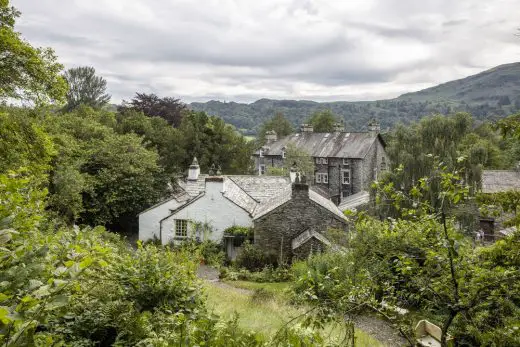
photo : Gareth Gardner
Dove Cottage and the Museum at Wordsworth Grasmere
Grizedale Forest Education Centre, Lake District
Design: Sutherland Hussey Architects
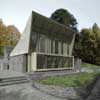
image from architects
Cumbrian building : Grizedale Masterplan – Architecture Competition – winner
The Love Shack, Windermere
Design: Sutherland Hussey Architects
Windermere House
Comments / photos for the Windermere Steamboat Museum Cumbria – Lake District Architecture Competition page welcome

